The Grass is not Always Greener that is, on Natural Grass
©
More from this issue
Michael Vick is, arguably, the most exciting player today in the
National Football League. Considered an outstanding runner as well
as passer, one of the most essential ingredients to his success
is wearing the proper football shoe. The way he cuts and slides
as a runner and the way he pivots and changes direction as a passer,
the right cleat is clearly indispensable to someone at his level.
Vick, though, wears a different football shoe than an offensive lineman, linebacker
or defensive back. For play on natural grass, a skilled-position football player
needs the lightest shoe possible where speed is of the essence. Clearly traction
and the ability to cut on a dime are important, but maximizing speed is the ultimate
priority.
That’s not the same priority for a lineman. An offensive guard or a defensive
tackle should examine a shoe’s durability, research heavier shoes that
will take a pounding and provide more torque, and inquire about traction. A linebacker’s
shoe should include elements of both: lightness and quickness for speed and proper
traction and durability to help close on a tackle.
Eastbay, the company that knows shoes, believes players at every level and at
every position should examine the following items before making a purchase. According
to James Ochs, Eastbay’s Fit Technician, there are a number of items to
consider before buying a shoe for a natural grass surface, regardless of position:
1. Versatility: shoes should be able to wear well on natural grass regardless
of the weather conditions. Many athletes should find a shoe with detachable cleats
so that – depending on the climate – maximum traction is attained.
2. EVA Wedge: Players should ask if the football shoe they want includes an EVA
wedge (Ethyl Vinyl Acetate). This is a substance on the sole of the cleat that
helps provide better support for the entire foot.
3. Comfort: Each player should try on a number of shoes before determining a
maximum comfort level. Many athletes at all levels typically buy a shoe size
either a half or full size too small. This may result in anything from numbness
to a form of turf toe. Remember: the toes must have room to wiggle.
4. Style: Obviously an important factor in determining the right shoe but not
the top priority. Many styles now favor additional lacing for support and should
be a consideration before purchase.
Each player should also determine if they need detachable cleats; that is, shoes
in which the individual plastic cleats can be removed for longer ones. For example,
1/2 inch cleats are the normal size used on natural grass, but, depending on
weather conditions, a running back may feel he needs a 3/4 cleat on a wet surface
to provide better cutting ability. If the natural surface is wet, a player should
allow enough time to test cleat size to ensure maximum traction.
The following pages should give you a better idea of the types of football shoes
now available for today’s athlete.
Nike Vapor TD
Super lightweight NikeSkin upper, an ultra thin
material that conforms to the natural cuvatures of the foot.
The sculpted arch provides stability and comfort.
An external heel counter gives stability and heel fit. A PEEVAFitform sockliner
with Poron™ inserts mirrors the natural contours of the Footform Last
to enhance comfort and cushioning. Nikeframe contoured glass filled nylon structural
plate creates stability and enhances immediate take off as the platform returns
rapidly to its original characteristics. The football placement of the studs
is designed for maximum traction, precise cutting, and acceleration.
|
 |
Nike Air Zoom Veer D
The shoe that helped redefine cleated footwear.
Nubuck upper with midfoot “spat” strap
provides support and lockdown, dynamic fit tongue enhances fit. Contoured Phylon™ midsole
wedge with full-length Zoom Air™ unit delivers responsive cushioning and
disperses cleat pressure. Pebax® plate with metal-tipped cleats. Seven-stud
cleat configuration with secondary TPU forefoot cleats.
|
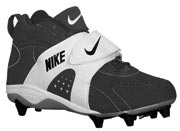 |
Nike Blade TD+
A speed shoe for the big guy. Lightweight synthetic
leather upper with midfoot support strap and dynamic innersleeve
for an ideal combination of performance
feel, fit and support. Performance sockliner with Poron™ inserts in key
pressure areas enhances cushioning while keeping low-to-the-ground feel. Molded
TPU Speed TD outsole.
|
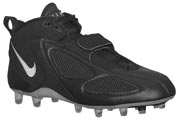 |
Nike Air Zoom Boss Shark 3/4
The ultimate “big man” shoe built on a “big man” last.
Synthetic leather upper with midfoot overlay and spat strap. Phylon™ wedge
midsole with forefoot and heel Zoom Air units provides low-profile cushioning.
TPU Shark traction pattern outsole, glass reinforced nylon shank adds rigidity
and protection.
|
 |
adidas Pro Model D Patent
Lightweight synthetic patent leather upper with
patented rubber shell-toe. CMEVA midsole, molded EVA sockliner
with heel and forefoot adiPRENE® inserts.
Lightweight
injected Peebax® plate.
|
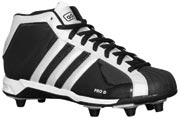 |
Reebok Outside Speed Mid D
Synthetic leather upper requires little break-in. Non-stretch lining offers consistent
fit. EVA sockliner with ETC top cover reduces friction and heat build up. TPU
plate delivers excellent traction.
|
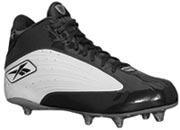 |
Reebok Burner Speed
Lightweight upper with mesh quarters and injected TPU stability cage, adjustable
closure strap. Molded EVA sockliner with ETC top cover reduces friction and
heat build up. Molded TPU plate adds traction, glass reinforced nylon innersole
offers
stable platform.
|
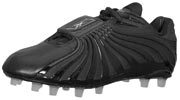 |
Air Jordan XIII D Mid
The football version Air Jordan XIII basketball
shoe. Leather/suede upper, C-EVA wedge midsole withZoom Air™ unit. Seven-stud Pebax® outsole.
|
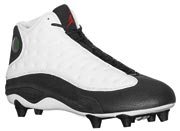 |
adidas Superstar TrX
Made for college level/elite high school speed
players. Synthetic patent leather upper with rubber shell toe.
Internal LightStrike™ EVA cushioning system,
molded EVA sockliner with adiPRENE®+ forefoot insert, Pebax® and TPU
football specific TraXion™ plate.
|
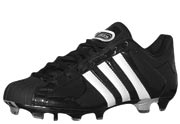 |
adidas Scorch 3 D
The adidas Scorch 3 D is for speed players who
want a lightweight shoe. Synthetic leather upper. Internal
Lightstrike™ EVA cushioning system. EVA sockliner
with adiPRENE®+ forefoot insert. Injected Pebax® plate.
|
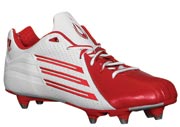 |
Air Zoom Apocalypse III
Lightweight synthetic leather and breathable
mesh upper. Full-length Zoom Air unit sockliner, injected innersole.
Revolutionary full Pebax® outsole chassis
with medial and lateral wraps for increased support.
|
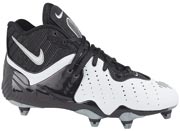 |
Nike Land Shark
The first Land Shark with a Phylon™ midsole
wedge. Synthetic/mesh upper, supportive lacing system enhances
fit. Rubber Shark outsole with aggressive bi-level
cleats gives traction on natural and synthetic grass. |
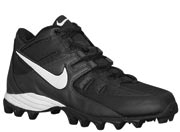 |
CLEAT
TYPES
Detachable: The most versatile and popular cleat on the market. They perform
best in normal to wet conditions where the grass is not too firm. Cleat
length can be changed to accommodate terrain.
Molded: Football cleats that
are non-removable. They are great for hard surfaces and heavier players
because they absorb more body weight. Molded shoes are more affordable
than detachable cleats.
Turf: Turf football cleats are designed specifically
for use on artificial surfaces. In fact, they resemble sneakers more than
cleats. Some turf shoes have rubber nubs on the soles used to grip artificial
turf. |
SHOE ANATOMY
Upper: Upper portion of the shoe keeps the foot in the shoe while providing
some support to the foot.
Insole: Part of the shoe that provides comfort and keeps foot from sliding
inside of shoe.
Midsole: Located between the upper and outsole of shoe. Not all football
shoes offer a midsole. Provides comfort and support.
Outsole: Most important part of the football shoe. It is the bottom of
the shoe which includes the shoe’s traction properties.
- James Ochs, Eastbay-Footlocker Fit Technician |
FOOTSTEPS:
Know your players’ feet ...
Choosing the right shoe is critical to the success of your
players’ game. In order to maximize your athletes’ performance,
you must first pay attention to the correct shoe and the correct
fit. If you or your players are unaware of their foot type,
Eastbay-Footlocker Fit Technician James Ochs suggests consulting
a podiatrist to determine what type of support will enable
a player to peform at peak levels. |
Wet Foot Test
Which foot are you?
Take the “Wet Foot” test
Simply wet your feet and stand on any surface that will
leave an imprint. Then take a look at your footprint.
Most feet will
fall into one of the three major categories: flat arch,
normal arch or high arch. |
WEAR-OUT POINTS
Shoes generally wear out
in one of three places:
Heel Strike - Shoes wear on the outsole at the point of heel
contact to the surface. Associated with high-arched feet.
Mid-stance - Shoes wear at the mid-foot area around the arch.
Associated with flat feet.
Toe-off - Shoes wear on the outsole near the big toe or medial
side. Associated with normal-arch feet. |
FOOT TYPES:
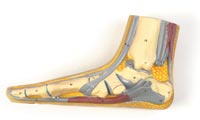
Flat Arch - Feet tend to over-pronate. Look for motion-control
shoes to control the motion of your heel. Avoid highly cushioned
shoes, because they provide less stability and control.
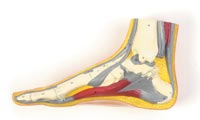
Normal
Arch - Feet neither over-pronate or under-pronate. Normal
arch does function best with cushion and moderate control features.
This foot type is not as common as the flat foot.
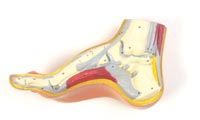 High Arch - Feet tend to under-pronate. This foot is often called
a supinated foot. Look for cushioned shoes with lots of flexibility
to promote foot motion. Avoid motion-controlled shoes.
High Arch - Feet tend to under-pronate. This foot is often called
a supinated foot. Look for cushioned shoes with lots of flexibility
to promote foot motion. Avoid motion-controlled shoes.
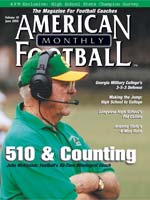
















 High Arch - Feet tend to under-pronate. This foot is often called
a supinated foot. Look for cushioned shoes with lots of flexibility
to promote foot motion. Avoid motion-controlled shoes.
High Arch - Feet tend to under-pronate. This foot is often called
a supinated foot. Look for cushioned shoes with lots of flexibility
to promote foot motion. Avoid motion-controlled shoes.


